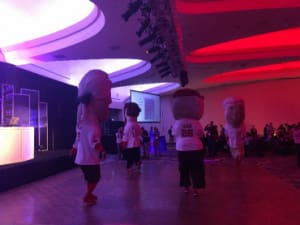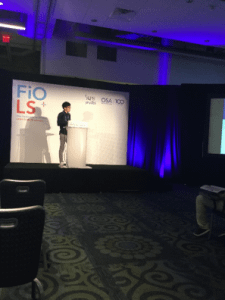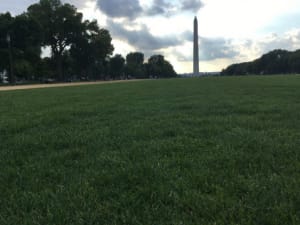FiO 2017 Shun Fujii
Research
Frontiers in Optics 2017 Report
Master2Year: Shun Fujii
Dates September 17 - 21, 2017
Venue Washington Hilton, Washington DC, USA
About the Conference
The FiO is the 101st annual meeting of the OSA, where many of the latest research in the field of optics and photonics is presented. This year, a total of 718 papers, including oral and poster presentations, were presented in 55 sessions over the four days of the conference, and many lively discussions took place. The center of Washington, D.C., can be reached by direct flight from Dulles International Airport, which takes about 13 hours, and by public transportation, which takes about one hour more. As the political center of the United States, D.C. is home to the White House, the Capitol Building, and other buildings that can be considered the nation's center of government. The National Mall, with its bright green lawn, and the Smithsonian Institution, which offers free admission, are located nearby, attracting many tourists. The Smithsonian Institution's overwhelming collection and cultural value are unmatched anywhere in the world, and the fact that they can be seen for free is astonishing.
This time, I was able to attend the banquet that also served as the awards ceremony, and I was able to deepen my friendship with students of my generation. The banquet was quite enjoyable with various events such as an impersonation of President Trump, but the other Korean student and I were suffering from jet lag. The reception party at the conference featured elaborate lighting and other lighting effects, giving the impression that this was a conference specializing in light. In addition, four giant stuffed animals that appear in the "President's Race," a famous event of the Washington Nationals, a local baseball team, interrupted the reception party and enlivened the venue with their awkward dance moves.
2. own presentation
This presentation was on a normally dispersive optical carcom in a coupled resonator system using the nonlinear coupled mode equation. In addition to the usual poster presentation, several participants were selected for the Rapid Fire Oral presentation. The short preparation period and the countdown time limit made the presentation a little tense. After the presentations, we immediately moved to our posters for discussion. I am not sure if the rapid fire system had any effect, but fortunately, more people came than I could handle alone, which gave me some satisfaction. In particular, I had a very fruitful discussion with a student of C. Menyuk's group, which is strong in the theory of optical carcoms, and was able to confirm once again the appeal points of my research. I was also asked for advice by someone who wanted to start computing nonlinear coupled mode equations, and I introduced some papers and algorithms that would be useful. As the Com group of Tanabe Lab, which has been blindly chasing after the top group, we are happy to receive such comments, but we must continue our research with even more determination because we are now facing a new competitor.
3. introduction of related research
[JTu3A.14] Dark Solitons and Cnoidal Waves in Microresonators with Normal Dispersion
C. Menyuk's group, which is strong in the theory of optical CURCOM, presented a poster paper. cnoidal wave is an unfamiliar term, but it seems to mean a periodic solution of the wave equation, which is basically the same thing as turing pattern (roll). A student's presentation, which I discussed in my poster presentation, was mainly an analytical study of periodic solutions of LLE in the normal dispersion regime. The content of the paper was quite difficult to understand. The conclusion was that it is easy to find periodic solutions in anomalous dispersion, while it is more difficult to reach periodic solutions in normal dispersion than in dark solitons. Although this is a qualitatively well-known phenomenon, it may be worthwhile to mathematically prove such a matter. The calculations of optical CURCOM performed at Tanabe Lab are not mathematical analytical solutions, but rather numerical solutions, which is a very different approach. Since this type of theoretical research is quite difficult for us, we were surprised that they were interested in our research.
[FTu4B.5] Efficient visible frequency microcomb generation with 22% conversion efficiency
Since both second-order nonlinear optical effects (Pockels effect) and third-order nonlinear optical effects (Kerr effect) exist in aluminum nitride resonators, when pumping in the 1550 nm band, optical Kerr combs occur at both 1550 nm and 780 nm. In this study, we focused on the generation of Cherenkov-like radiation (dispersive waves) when the pump and SH modes combine through nonlinear processes, and achieved a conversion efficiency of 221 TP2T from pump light to visible light. The fact that the parametric coupling of the pump and SH modes was used to achieve this high efficiency is interesting, since there have been several studies on visible light comb generation using harmonics, but all of them have the problem of low efficiency. Currently, due to the low Q-value and high threshold power, a CW laser is pumped with EO-modulated 10 ns square pulses (10 W peak power after amplification). By using pulses that are sufficiently longer than the resonator lifetime of 1 ns, the pseudo-CW (quasi-CW) pumping state is said to be sufficient to generate carcombs. However, the problem is that the resulting comb has low coherence due to pulse excitation and the thermal properties of the material. Simulations show that solitons can be achieved by CW pumping, and it is interesting to see what happens to the coherence in the visible light band when this is done.



- Categories
- 国際会議報告


